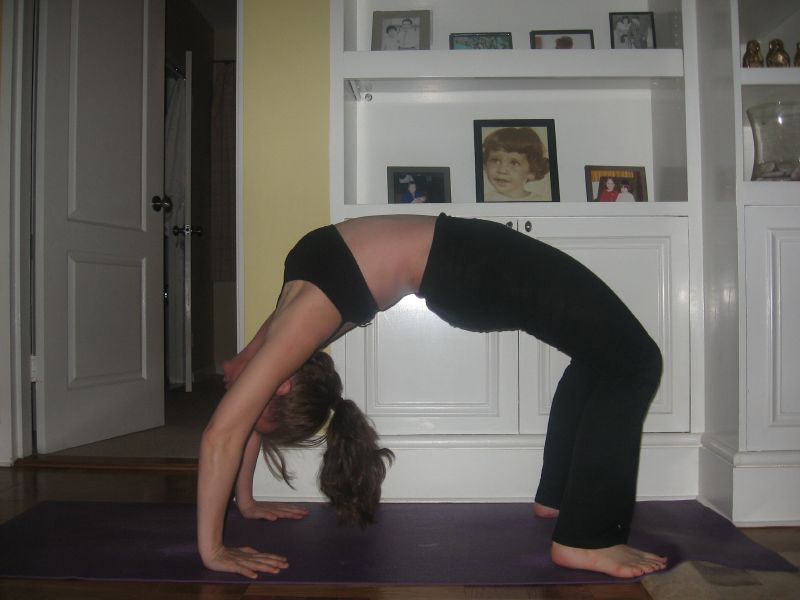This is my brain on OCD
As I went down the slippery slope of finding myself participating in more and more and more of the Ashtanga Intensive at Ashtanga Yoga Shala, until I found that I was participating in every module (other than Anatomy, which I already studied aplenty at Om), it quickly became clear that the object of my obsession would be the Sanskrit counting. I found the alignment explorations interesting to be sure, but ultimately, what has captivated my attention and my energy seemingly endlessly is the Sanskrit counting, specifically:
- how the vinyasas within each asana are counted
- which count represents the state of the pose,
- which count represents the "lift up" before the chatturanga, how many vinyasas comprise the asana (although the answer to this in each case is always three counts past the "lift up"), along with what takes the place of the "lift up" in seated postures that don't include it, for example, Purvatanasana
- how and why the vinyasa count for each asana is similar or different (or both) to the vinyasa count for each other asana.
Along with my notes from Lori's lectures, I have been poring through Yoga Mala and listening carefully to Sharath's Primary Series DVD. Because I seem to have found myself with some time on my hands, I decided to boil all of my research down to the simplest form, which for me turns out to be a summary of which vinyasa represents the state of each asana, because once you know that, you can pretty much figure out the rest if you realize a few basic things, namely, that:
- each jump-through-to-sit happens at Sapta (or Catordesha, if it is an asana with a right and a left side).
- most of the standing poses have five or fewer vinyasas (the exceptions being Uttitha Hasta Padangushtasana, Ardha Badha Padmotannasana and Virabhadrasana)
- all of the postures from Purvatannasana through Mari B have the same vinyasa count, which is 22, 13 being the downward dog in the middle, 14 being the jump through in the middle
- Every chatturanga is followed by a downward dog two breaths later
- Every full-on forward bend (one which involves chest to thighs) is initiated with an inhale-head-up and is followed by an inhale-head up.
With that in mind, the following makes perfect sense to me (and probably leaves you with eyes glazed over):
States of Each Asana:
1. Standing Poses
Padangushtasana - Dwi (total = 3 or trini)
Padahastasana - Dwi (total = 3 or trini)
Trikonasana - Dwi and Chatwari (total = 5 or pancha)
Parsvakonasana - Dwi and Chatwari (total = 5 or pancha)
Prasarita Padottanasana - Trini (always inhale, then Trini Exhale) (total = 5 or pancha)
Parsvakonasana - Dwi and Chatwari (total = 5 or pancha)
Uttitha Hasta Padangushtasana - Dwi, Chatwari, Sapta/Nawa, Ekadesha, Chatordesha) (total is 14 or chatordesha)
Ardha Baddha Padmottanasana - Ekam, Dwi/Shat, Sapta (total is 9 or nawa)
Utkatasana - Sapta (Ashau is a handstand-like liftup, and the total is 11 or ekadesha)
Virabadhrasana - Sapta, Ashtau, Nawa, Desha (Ekadesha is a handstand-like liftup, and the total is 14 or chatordesha)
2. First Half of Primary Series
Paschimattanasana - Sapta (Dandasana), Nawa (head up is Desha, press up is Ekadesha) (total is 14 or chatordesha)
Purvatanasana - Ashtau (press up is Desha) (total is 13 or triodesha)
Ardha Baddha Padma Paschimattanasana - Ashtau, Panchadesha (head up is Nawa,/Shaudesha, press up is Desha/Saptadesha) (total is 20 or vimshathiti)
Tirianga Mukhaikapada Paschimattanasana - (same as Ardha Baddha)
Janu Sirsasana A, B, C - (same as Ardha Baddha)
Marichyasana A and B - (same as Ardha Baddha)
Marichyasana C and D - Sapta, Dwadesha (press up is Ashtau and Triodesha) (total is 16 or shaudesha)
Navasana - Sapta (press up is Ashtau….five times) (total is 11 or ekadesha)
3. Second Half of Primary Series
Bhujapidasana - Sapta (not held), Ashtau (Bakasana is Desha) (total is 13 or triodesha)
Kurmasana/Supta Kurmasana - Sapta, Nawa is Supta K (Bakasana is Ekadesha) (total is 14 or catordesha)
Garba Pindasana/Kukkutasana - Ashtau (rolling clockwise), Nawa is Kukku (Uth Pluthi is Desha) (total is 13 or triodesha)
Baddha Konasana - Ashtau (twice), Nawa (hold the second Nawa only in Mysore practice, not in led class) (press up is Desha) (total is 13 or triodesha)
Upavishta Konasana - Ashtau, Desha (Nawa is inhale head up, press up is Ekadesha) (total is 14 or catordesha)
Supta Konasana - Ashtau (Nawa is inhale ROLL up, exhale calves down; Desha is lift head, Ekadesha is lift up) (total is 14 or catordesha)
Supta Padangushtasana - Nawa, Ekadesha, Saptadesha, Ekaunavimshathiti, (Catwarivimshathiti is chakrasana to chatwari) (total is 26 or shatvimshathiti)
Ubaya Padangushtasana - Nawa (press up is Desha) (total is 13 or triodesha)
Urdhva Mukha Paschimattanasana - Desha (press up is Dwadesha) (total is 15 or panchadesha)
Setu Bhandasana - Nawa (Ashtau is prepare, Desha is down, Ekadesha is Chakrasana) (total is 13 or triodesha)
4. Finishing Poses (including Urdhva Dhanurasana)
Urdhva Dhanurasana - Ashtau (Desha is Chakrasana)
Paschimattanasana - Nawa
Sarvangasana - Ashtau
Halasana - Ashtau
Karna Pidasana - Ashtau
Urdhva Padmasana - Nawa (Ashtau got the practitioner back to Sarvangasana from Karna Pidasana)
Pindasana - Nawa
Mats asana - Ashtau
Uttana Padasana - Ashtau (Nawa is Chakrasana)
Sirsasana - Ashtau (Sapta is bringing the shins to the floor and preparing)
(I haven't gotten around to analyzing Baddha Padmasana/Yoga Mudra, Padmasana and Uth Pluthi, but I have a feeling that there will never be an occasion for me to count those out in Sanskrit anyway.)
Obsessively yours,
YC








3 comments:
Thank you.
where do you get all this time? you must have a nanny. and yes, um, my eyes have glazed over.
Impressive work! Checked the counts from Petri's excellent book and they seem to match. Wonder why it's not been released in english yet.
Post a Comment